During I-STEM Summer Camp, Urbana High School Students’ Understanding of Aerospace Engineering Soars
October 9, 2017
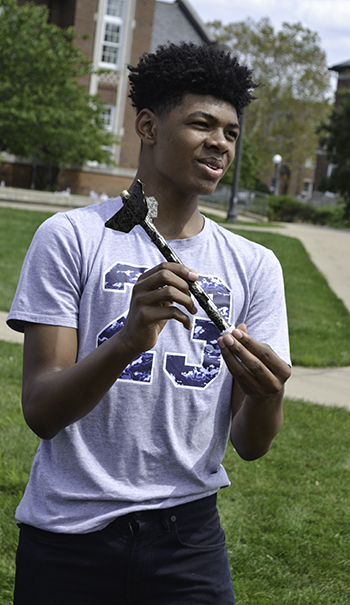
A UHS student hopes his rocket will fly the highest on Bardeen Quad
Amidst cheering, laughter, and lots of trash talking, the 27 Urbana High School (UHS) student athletes at I-STEM’s first-ever, multidisciplinary summer camp were attempting to launch (some successfully, some not so successfully) the balsa wood gliders and model rockets they had built. It was Aerospace Day on Monday, August 14. Students had learned some of the engineering and physics behind how airplanes and rockets fly: via several brief lectures, demonstrations, tours, and lots of hands-on activities, the students had learned about flight mechanics and jet engines, the basics of rocketry, and experienced in the wind tunnel how the aerodynamics of various shapes are tested. Then, after designing and building their masterpieces, they came to the high point of the day—a chance to attempt to launch their aircraft.
The day began with a brief introduction about Aerospace Engineering from Bliss Professor and Department Head Philippe Geubelle, then a couple of Aerospace grad students shared about current research on the shape of airplanes and how to improve rockets.
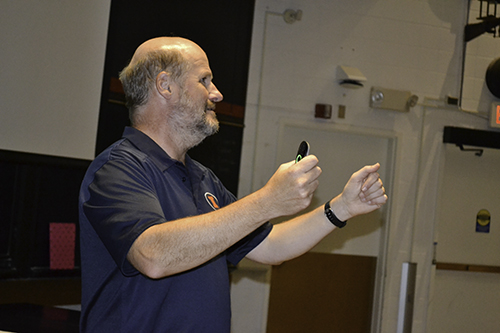
Aerospace Engineering Department Head, Philippe Geubelle, welcomes the I-STEM Campers
The UHS students then visited Talbot lab, home of Aerospace Engineering. During a tour, students saw several Rolls-Royce jet engines used for teaching purposes, learning about some of the different designs and how they’d been uses in aircraft in the past. Students also visited the wind tunnel lab for a demonstration of testing the aerodynamics of different shapes, and saw how light and mirrors are employed to show the air movement created by those shapes.

Aerospace Engineering grad student Matt Koll explains aerodynamics testing in the Talbot wind tunnel lab.
The day wasn’t just about instruction and tours. Students actually created their own aircraft. They made Balsa Wood Gliders which they “flew” in one of Talbot’s long halls to test how they could change the way their plane flew by using different weights and positioning pieces in different ways.
After learning the basics of rocketry, the students then built their own rockets. To make the activity a bit more interesting, the instructors made it a competition: using the principles of aerodynamics and rocket design they’d learned, they were to create a rocket that would fly the highest. And of course each aircraft was unique, reflecting each student’s personality. Then, toting the aircraft they’d built, they retired to Bardeen Quad to see if they would fly, and if so, how long and how high.
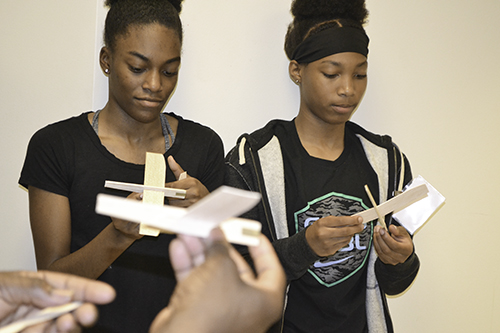
Two I-STEM campers making balsa wood gliders
While some tested their rockets, others students explored Alka-Seltzer Rockets. Combining Alka-Seltzer tablets and water in a film canister, the students then closed the lid and tipped them upside down until enough pressure built up to cause the main body of the film canister to shoot up into the air.
Elle Wroblewski, an Aerospace Ph.D. student who helped with the camp, shares why events like the camp are important for high school students.
“When I was in high school,” she explains, “my impression of engineering was only based off of what older people would tell me; I didn't have any first-hand experiences as to what that meant. An event like this shows students more in depth and gives them a better grasp as to what engineering is and shows them a practical application in math and science, whereas beforehand, I feel like it's a little more theoretical, or it's a bit more science-fiction based."
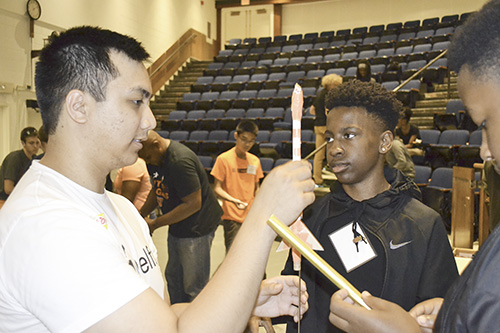
An aerospace student instructs an I-STEM camper on proper rocket-building technique.
In fact, Wroblewski says that much of what kids believe about space flight is based on what they’ve seen in movies and on TV and “not so much on the technical details,” she admits. “An event like this makes it more realistic, so that when they're thinking about careers, they have a better grasp as to what it actually is.”
More importantly, Wroblewski says these types of events show them that they have what it takes to be engineers, refuting “pre-conceived notions like ‘I can't do that because I'm not smart enough,’ because they've experienced that they are smart enough to do it. It's exciting and fun that they can achieve something as opposed to not knowing whether or not they could.”
Aerospace Day definitely impacted the UHS students in a positive way. For instance, Damuzha Moore indicated that Aerospace Engineering might be one of his choices for college.
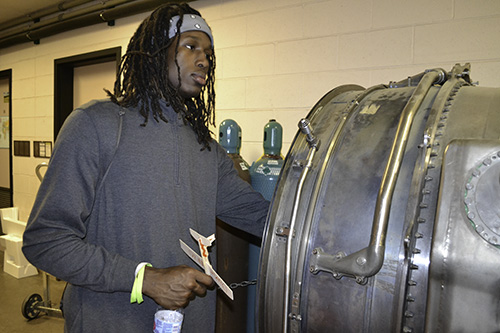
During a tour of Talbot Lab, a UHS student examines a Rolls-Royce jet engine.
Kuanu Duke reports that one of his favorite days was probably Aerospace Engineering, with its intriguing hands-on activities: “because we did interactive stuff—like we were touching and building stuff.”
Jeremiah Hamilton indicates that his favorite day was “Rocketry: I do this for Boy Scouts and other things like that.”
One student, Damuzha Moore, was particularly intrigued by the jet engines. “Aerospace Engineering has been my favorite,” he explains, “because it’s focused all on the jet engineering, and the engines and all that.”
One of the I-STEM mentors, Kushal Geonka, was hopeful that Aerospace Day and I-STEM camp might influence some of the students to consider careers in STEM fields: “I just hope at the end of these two weeks, some of them will decide on STEM careers, some of them will think of what they want to do in the future and that it may be related to science, technology, engineering, and mathematics.”
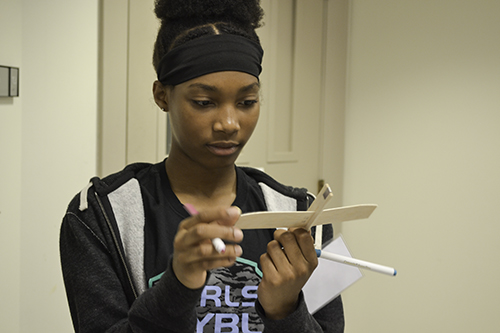
A UHS student builds a glider during one of the Aerospace Day hands-on activities.
Author/Photographer: Elizabeth Innes, Communications Specialist, I-STEM Education Initiative
More: 8-12 Outreach, Aerospace, I-STEM Initiatives, STEM Pipeline, Summer Camp, Underserved Students/Minorities in STEM, Urbana High School, 2017
For additional articles about I-STEM's 2017 Summer Camp, see:
- I-STEM Multidisciplinary Summer Program Exposes UHS Athletes to Different STEM Departments/Units
- MCBees Use “Whodunit?” to Pique UHS Students’ Interest in Science During I-STEM Summer Camp
- MNTL Day Exposes UHS Students to Nanotechnology Research During I-STEM’s Summer Multidisciplinary Camp
- Akono and Company Teach UHS Students About Civil Engineering and Strength of Materials During I-STEM’s Multidisciplinary Summer Camp
- ECE Day at I-STEM’s Multidisciplinary Summer Camp: Soldering, Circuits, and Software
- Math Day at I-STEM’s Multidisciplinary Summer Camp Adds Up to Fun
- UHS Students Explore Computer Science, Coding, During I-STEM Camp’s CS Day
- At I-STEM's Multidisciplinary Summer Camp, UHS Students Have Fun with Chemistry—Everything From Soap Making To Glow Sticks to Ice Cream
- UHS Students Gear Up for Mechanical Science and Engineering During I-STEM Summer Camp
- During I-STEM Camp’s NCSA Day, UHS Students Experience Data Visualization, Super Computers, and NCSA’s Research
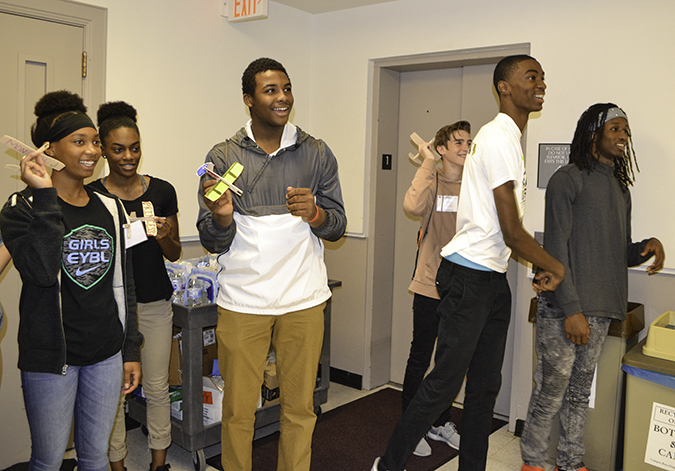 Above: Students fly the gliders they built in the halls of Talbot Lab.
Above: Students fly the gliders they built in the halls of Talbot Lab.
Below: During a tour of the Aerospace Engineering Department, I-STEM campers and mentors view a Rolls Royce rocket engine housed in basement of Talbot Lab.
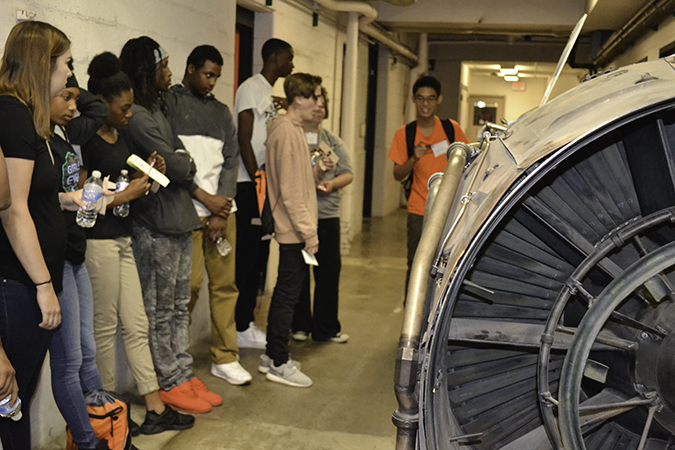













.jpg)
















